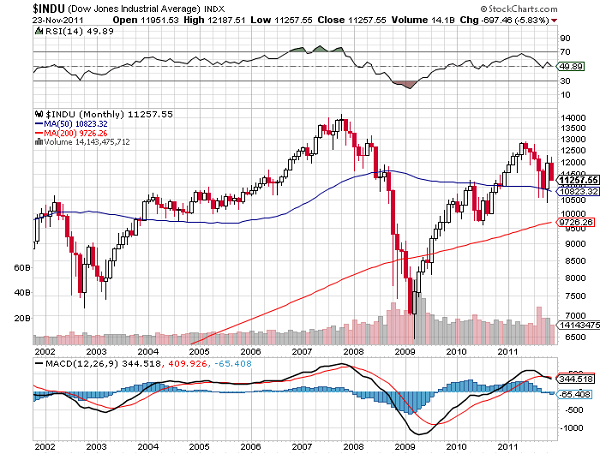
There are several theories as to why markets tend to rise in December one being that the rally is due to buying pressure from portfolio rebalancing, while another theory is that the rally could be caused by end-of-year bonuses entering into the market. Still another theory is that the rally is merely psychological, based solely on the jovial mood of the holidays.
The market does tend to go up over time, and generally the market goes up more in the month of December, with the Dow Jones Industrial Average rising an average of 1.2% in December, versus gains of 0.5% in the previous twelve months.
Santa Rally Theory Questionable Even Under The Best Of Circumstances
Even in the best of years the view that a stock market rally will occur every December is questionable, and extremely flawed in the current market environment. In this age of extreme market swings, keep in mind that the “average” strength of December fails to account for this volatility.
It is in fact a dangerous trading strategy to invest based on generalizations, and the Santa Rally is no different.
Political gridlock in the United States, illustrated lately by the failure of the United States Super Committee, as well as the ongoing European debt crisis have ignited concerns over the state of the global economy, causing extreme volatility in the markets.
With the past year seeing the markets tumble on insidious rhetoric and brinksmanship, the market appears to be spooked over the latest round of political failure and economic fears. Additional bad headlines could serve to sour investors further, and a vast amount of large issues at play will make it unlikely that the stock market will get its usual break from big news.
Market Volatility May Make Santa Rally Unlikely
Even in the event of a meaningful breakthrough in the Euro zone debt crisis, the markets could react with intense volatility in the days leading up to a resolution. Add to that the pain that is already being felt in the market in light of the failure of the [intlink id=”2156″ type=”post”]Super Committee[/intlink], and an increasing concern over rising inflation, and the prospects for a Santa Rally seem even more unlikely.
While developed nations struggled with recovering from recession in last two years, emerging markets in countries such as Brazil and China have bore the brunt of carrying the global economy, and now even those markets appear to be at risk of slowing down in the short-term.
From the threat posed by rampant inflation in Brazil, to the feared “hard landing” in China, it will not take much from trouble in these emerging markets to shake up markets in the United States.
Investors could be cheered by some decently positive headlines coming through these days, including generally good earnings for companies in the third quarter, a rise in home building numbers, and slight improvements to the labor market, although these reports may do little to overshadow the trouble seen in the last few years.
In order for the markets to see a meaningful rally – Santa or otherwise – the situations that are weighing on the economy must be dealt with in a substantive way. The country must first get a handle on unemployment, housing prices need to stabilize and faith in the financial system needs to be restored – that’s a tall order for Santa.
Comments (No)